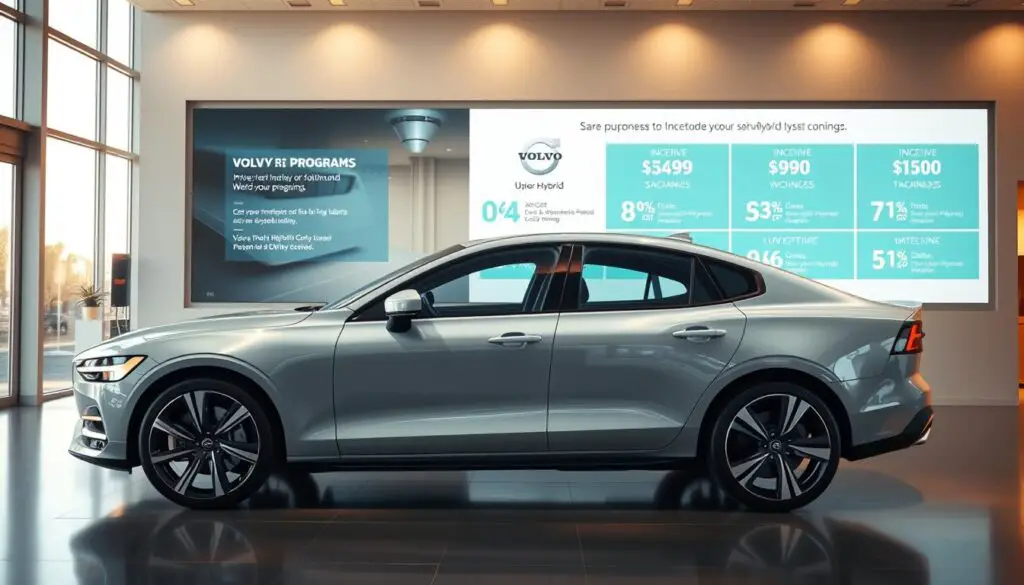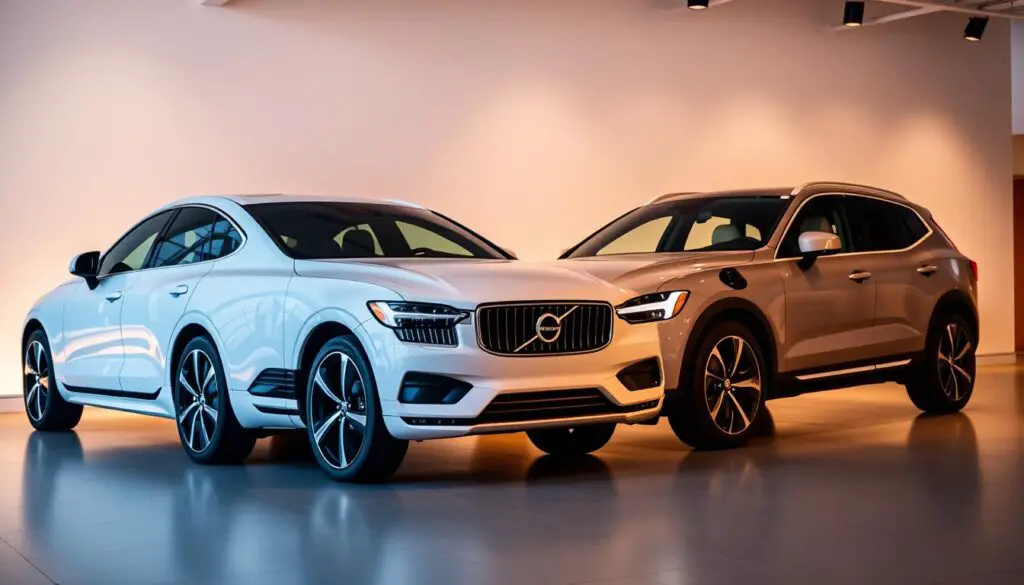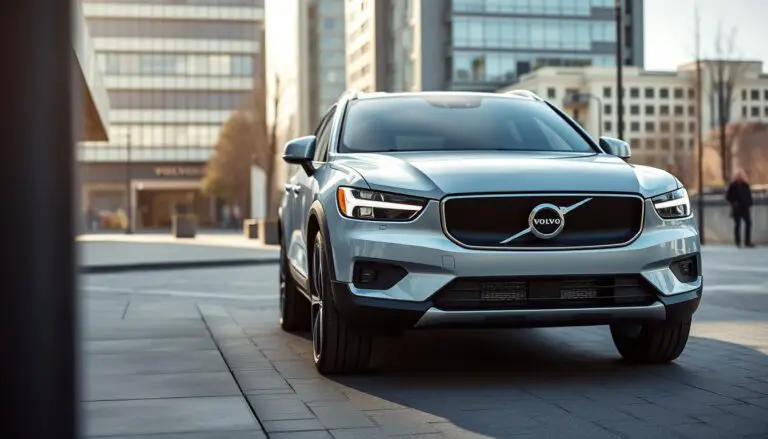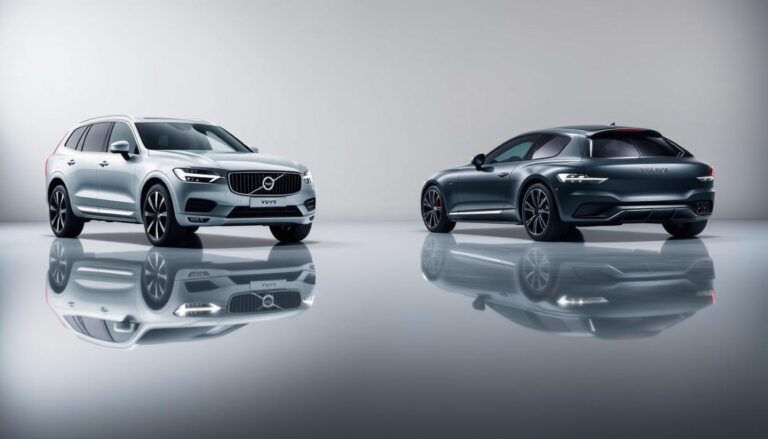The automotive landscape is shifting towards more sustainable options, and Volvo’s hybrid technology is at the forefront of this change. As consumers consider their next vehicle, understanding the differences between Mild Hybrid and Plug-in Hybrid models is crucial.
Volvo offers a range of hybrid models, each with its unique benefits. For those looking to reduce their carbon footprint without compromising on performance, understanding the nuances of hybrid options is essential. The key lies in the technology behind these vehicles, including their electrification capabilities and how they enhance the driving experience.
Key Takeaways
- Understanding the difference between Mild Hybrid and Plug-in Hybrid technologies.
- Exploring the benefits of Volvo’s hybrid offerings.
- Learning about the available models for each hybrid type.
- Discovering how Volvo’s electrification enhances vehicle performance.
- Comparing the electric driving range and charging methods for Plug-in Hybrids.
Understanding Hybrid Technology in the Automotive Industry
As concern for the environment grows, hybrid technology is playing a crucial role in the automotive industry’s evolution. Hybrid vehicles combine the benefits of electric and gasoline-powered engines, offering improved fuel efficiency and reduced emissions.
The Evolution of Hybrid Vehicles
The concept of hybrid vehicles dates back to the late 19th century, but it wasn’t until the late 1990s that the first mass-produced hybrid car, the Toyota Prius, was introduced. Since then, hybrid technology has advanced significantly, with various models now available across different segments.
The evolution of hybrid vehicles has been driven by advances in battery technology, electric motors, and combustion engines. Modern hybrids are more efficient, powerful, and environmentally friendly than their predecessors.
How Hybrid Systems Work
Hybrid systems work by combining the power of electric motors and combustion engines. The electric motor is powered by a battery, which is charged through regenerative braking and, in some cases, by the combustion engine.
The battery and electric motor are key components of a hybrid system. The battery stores energy that is used to power the electric motor, while the electric motor provides additional power to the vehicle, improving fuel efficiency and performance.
Integration with Combustion Engines
In a hybrid vehicle, the combustion engine works in tandem with the electric motor. The combustion engine provides primary power, while the electric motor assists during acceleration and other high-demand situations, optimizing fuel efficiency and reducing emissions.
Volvo’s Commitment to Electrification
With a clear vision for a sustainable future, Volvo is aggressively pushing its electrification agenda across its vehicle lineup. This commitment is reflected in their comprehensive strategy to integrate hybrid technology into their vehicles, offering consumers a range of options that balance efficiency and performance.
Electrification Strategy and Timeline
Volvo’s electrification strategy involves a phased approach, with plans to offer mild hybrid, plug-in hybrid, and fully electric models across their lineup by the end of the decade. According to their timeline, Volvo aims to ensure that every new model introduced after 2025 will be either fully electric or a hybrid. For more insights on Volvo’s electrification plans, you can visit Green Car Reports for an in-depth preview of their 2022 mild hybrid models.
Current Hybrid Lineup in the US Market
Volvo’s current hybrid lineup in the US market includes a variety of models that cater to different consumer needs. The lineup is divided into mild hybrid and plug-in hybrid models, each offering unique benefits.
Mild Hybrid Models Overview
Volvo’s mild hybrid models, such as the XC90 and S60, utilize a 48-volt battery system to enhance fuel efficiency and reduce emissions. These models offer improved performance without the need for external charging.
Plug-in Hybrid Models Overview
The plug-in hybrid models, including the XC60 and S90 Recharge, offer the ability to drive on electric power alone for a significant distance, reducing reliance on the internal combustion engine. These models can be charged via an external power source, making them ideal for those with shorter commutes.
Volvo Mild Hybrid vs Plug-in Hybrid: Core Technical Differences
As Volvo continues to innovate in the hybrid space, understanding the differences between their mild hybrid and plug-in hybrid technology is crucial. The technical distinctions between these two systems are significant, impacting performance, efficiency, and overall driving experience.
Mild Hybrid Technology Explained
Volvo’s mild hybrid technology is designed to provide a more efficient driving experience without the need for external charging. At its core is the B-Series Engines combined with a 48V system.
The B-Series Engines and 48V System
The B-Series engines are a series of efficient petrol engines that, when paired with the 48V system, offer enhanced performance and reduced emissions. The 48V system includes a belt-integrated starter generator (BSG) that assists the engine during acceleration and recuperates energy during braking.
Regenerative Braking and Energy Recovery
A key feature of Volvo’s mild hybrid technology is its regenerative braking system, which captures kinetic energy and converts it into electrical energy stored in the battery. This process not only improves fuel efficiency but also reduces wear on the brakes.
Plug-in Hybrid Technology Explained
Volvo’s plug-in hybrid technology offers a more extensive electrification of the powertrain, allowing for significant electric-only driving ranges. The T8 Twin Engine system is at the heart of this technology.
The T8 Twin Engine System
The T8 Twin Engine combines a supercharged and turbocharged petrol engine with a high-performance electric motor. This setup provides exceptional power and torque, along with the ability to drive on electric power alone for considerable distances.
Battery Capacity and Electric-Only Range
The battery capacity in Volvo’s plug-in hybrids is significantly larger than in their mild hybrids, enabling an electric-only range that suits various driving needs. The exact range can vary depending on the model and driving conditions.
According to Volvo, their plug-in hybrid models offer “up to 50 miles of electric-only range,” making them ideal for daily commutes and short trips without using a drop of petrol.
“The future of motoring is electric, and Volvo is leading the charge with its innovative hybrid technology.”
Power and Performance Comparison
When it comes to Volvo’s hybrid lineup, understanding the differences between mild hybrid and plug-in hybrid models is crucial for making an informed purchase decision. The performance of these vehicles is a key factor in this decision-making process.
Engine Specifications and Power Output
Volvo’s mild hybrid and plug-in hybrid models have distinct engine specifications that impact their power output. Mild hybrids typically feature a smaller electric motor that assists the internal combustion engine, while plug-in hybrids have a larger battery and electric motor, allowing for extended electric-only driving.
Horsepower and Torque Differences
The horsepower and torque differences between mild and plug-in hybrids are notable. For instance, a mild hybrid Volvo might produce around 250 horsepower, while a plug-in hybrid version of the same model could offer up to 400 horsepower. The increased electric motor power in plug-in hybrids significantly boosts torque, enhancing acceleration and overall performance.
Performance Across Volvo’s Model Range
Volvo’s model range offers a variety of hybrid options, from the compact XC40 to the larger XC90. Each model’s performance is tailored to its specific hybrid configuration. For a comparison of how Volvo’s performance stacks up against other luxury brands, you can check out this analysis on Volvo vs Audi.
Acceleration, Handling, and Driving Dynamics
The acceleration, handling, and driving dynamics of Volvo’s mild hybrid and plug-in hybrid models differ significantly. Plug-in hybrids generally offer quicker 0-60 MPH times due to their ability to utilize electric power for instant torque.
0-60 MPH Times Comparison
A comparison of 0-60 MPH times reveals that plug-in hybrids are typically faster than their mild hybrid counterparts. For example, a plug-in hybrid Volvo might achieve 0-60 MPH in under 5 seconds, while a mild hybrid version might take around 6 seconds.
Weight Distribution and Handling Characteristics
The weight distribution and handling characteristics of these vehicles are also influenced by their hybrid configuration. Plug-in hybrids often have a lower center of gravity due to the placement of the battery pack, which can enhance handling and stability.
Fuel Efficiency and Environmental Impact
Fuel efficiency and environmental impact are key factors in choosing between Volvo’s hybrid vehicles. As the automotive industry shifts towards more sustainable options, understanding the nuances of these technologies is essential.
MPG Ratings and Real-world Efficiency
The MPG (miles per gallon) ratings of Volvo’s mild hybrid and plug-in hybrid models vary significantly. According to the EPA, the mild hybrid models offer an estimated 25-30 MPG in combined driving, while the plug-in hybrids can achieve 50-70 MPGe (miles per gallon of gasoline-equivalent) when fully charged.
City vs. Highway Driving Efficiency
In city driving, the plug-in hybrids excel due to their ability to run on electric power alone, achieving up to 100 MPGe. In contrast, mild hybrids see a smaller improvement in city driving compared to highway driving. The table below summarizes the efficiency differences:
| Model | City MPG | Highway MPG |
|---|---|---|
| Mild Hybrid | 26 | 32 |
| Plug-in Hybrid | 102 MPGe | 92 MPGe |
Long-Distance Travel Considerations
For long-distance travel, the mild hybrids might be more convenient due to their ability to travel farther without needing to stop for fuel or charging. However, plug-in hybrids offer a viable option for those with access to charging infrastructure along their route.
Carbon Footprint and Emissions Comparison
The carbon footprint of Volvo’s hybrids is significantly lower than that of traditional gasoline-powered vehicles. The plug-in hybrids, in particular, offer a substantial reduction in CO2 emissions when operated in electric mode.
CO2 Emissions Data
According to official data, Volvo’s mild hybrids emit approximately 180-200 g/mi of CO2, while the plug-in hybrids emit 50-70 g/mi when combining electric and gasoline operation.
Environmental Benefits Over Traditional Engines
The environmental benefits of Volvo’s hybrids are clear. By reducing reliance on gasoline and lowering emissions, these vehicles contribute to a cleaner environment. As Volvo continues to electrify its lineup, the potential for further reductions in carbon footprint grows.
Cost Analysis: Purchase, Ownership, and Incentives
A comprehensive cost analysis is essential for making an informed decision between Volvo’s hybrid options.
Initial Purchase Price Differences Across Models
The initial purchase price of Volvo’s mild hybrid and plug-in hybrid models varies significantly. Plug-in hybrids typically come with a higher price tag due to their advanced battery technology and electric-only driving capabilities. For instance, the Volvo XC90 mild hybrid starts at around $50,000, while the plug-in hybrid version begins at approximately $60,000.
Here’s a breakdown of the initial purchase prices for some popular Volvo models:
| Model | Mild Hybrid Price | Plug-in Hybrid Price |
|---|---|---|
| Volvo XC90 | $50,000 | $60,000 |
| Volvo S60 | $40,000 | $50,000 |
| Volvo V60 | $45,000 | $55,000 |
Long-term Maintenance and Operating Costs
Long-term costs include maintenance, fuel, and potential repairs. Mild hybrids tend to have lower maintenance costs since they don’t require the complex battery management systems of plug-in hybrids. However, plug-in hybrids can offer significant savings on fuel costs, especially for those with short commutes who can often drive on electric power alone.
A comparison of operating costs over five years might look like this:
| Model | Fuel Costs (5 years) | Maintenance Costs (5 years) |
|---|---|---|
| Mild Hybrid | $8,000 | $3,000 |
| Plug-in Hybrid | $4,000 | $4,500 |
Available Federal and State Tax Credits and Incentives
Both federal and state governments offer incentives for purchasing eco-friendly vehicles. Understanding these can help offset the higher initial cost of some hybrid models.
Federal Tax Incentives for Plug-in Hybrids
The federal government offers tax credits for plug-in hybrid vehicles, which can be substantial. For example, the Volvo S60 plug-in hybrid may qualify for a credit of up to $4,500, depending on the battery size and other factors.
State-Specific Benefits and HOV Lane Access
Many states offer additional incentives, such as rebates, exemptions from certain fees, and access to HOV lanes, even if you’re driving alone. For instance, California offers a rebate of up to $5,000 for purchasing a plug-in hybrid vehicle, and access to HOV lanes can save time and reduce stress in heavy traffic.

Driving Experience and Usability
The usability of Volvo’s hybrid vehicles is designed to enhance daily driving. With a focus on both mild hybrids and plug-in hybrids, Volvo has optimized the driving experience to cater to various needs and preferences.
Daily Driving Considerations
Daily driving considerations play a significant role in the overall satisfaction with a Volvo hybrid. This includes driving modes and customization options, as well as the impact on cabin space and cargo capacity.
Driving Modes and Customization Options
Volvo’s hybrid models come equipped with various driving modes that allow drivers to customize their experience. From comfort-oriented modes to performance-driven settings, the options are designed to suit different driving conditions and personal preferences.
Cabin Space and Cargo Capacity Impacts
The design of Volvo’s hybrids ensures that cabin space and cargo capacity are not significantly compromised. While the addition of hybrid technology may slightly affect cargo space, Volvo’s engineers have worked to minimize this impact, ensuring ample room for passengers and luggage.
Charging Requirements and Infrastructure
For plug-in hybrids, charging requirements and charging infrastructure are crucial considerations. Understanding the options for home charging and the accessibility of public charging networks is essential for a seamless ownership experience.
Home Charging Solutions for Plug-in Hybrids
Home charging solutions offer the convenience of charging your Volvo plug-in hybrid from the comfort of your own home. Volvo provides options for home charging stations that can be installed to ensure efficient and safe charging.
Public Charging Network Accessibility
The accessibility of public charging networks continues to grow, making it easier to charge your Volvo plug-in hybrid on the go. Volvo owners can utilize a network of public charging stations across the country, reducing range anxiety.
Which Volvo Hybrid System Is Right For You?
Choosing the right Volvo hybrid system depends on understanding your driving habits and needs. Volvo’s hybrid lineup includes mild hybrids and plug-in hybrids, each designed to cater to different driving styles and requirements.
Ideal Driver Profiles for Mild Hybrids
Mild hybrids are suited for drivers who want improved fuel efficiency without the need for extensive electric-only driving. They are ideal for those with moderate driving habits.
Commuting Patterns Best Suited for Mild Hybrids
Drivers with shorter commutes or those who drive in heavy traffic may benefit from mild hybrids, as they offer better fuel economy in stop-and-go traffic.
Lifestyle Considerations for Mild Hybrid Owners
Mild hybrid owners typically don’t need to charge their vehicles frequently, making it a convenient option for those with limited access to charging infrastructure.
Ideal Driver Profiles for Plug-in Hybrids
Plug-in hybrids are perfect for drivers who can charge their vehicles regularly and want the flexibility to drive in electric-only mode for longer distances.
Commuting Patterns Best Suited for Plug-in Hybrids
Those with longer commutes or who drive mostly in urban areas can benefit from plug-in hybrids, as they offer significant electric-only range and reduced emissions.
Lifestyle Considerations for Plug-in Hybrid Owners
Plug-in hybrid owners should have access to regular charging, either at home or at work, to maximize the benefits of their vehicle’s electric capabilities.
| Hybrid Type | Ideal Commute | Lifestyle Benefit |
|---|---|---|
| Mild Hybrid | Short to Moderate | Convenience, Less Charging |
| Plug-in Hybrid | Longer, Urban | Electric-only Range, Reduced Emissions |

Conclusion: Making Your Volvo Hybrid Decision
Choosing between Volvo’s mild hybrid and plug-in hybrid models depends on several factors, including your driving habits, budget, and environmental concerns. By understanding the core technical differences, power and performance, fuel efficiency, and cost analysis, you can make an informed Volvo hybrid decision.
The mild hybrid technology offers improved fuel efficiency and reduced emissions, making it a suitable hybrid choice for those who drive primarily in urban areas. On the other hand, plug-in hybrid models provide the flexibility of electric-only driving, making them ideal for those with shorter commutes.
When selecting a Volvo hybrid model, consider your daily driving needs, charging infrastructure, and the available incentives. By weighing these factors, you can choose the Volvo hybrid model that best fits your lifestyle and preferences, ensuring a satisfying ownership experience.
Ultimately, Volvo’s hybrid offerings cater to a range of needs, providing a blend of performance, efficiency, and sustainability. By making an informed hybrid choice, you can enjoy the benefits of Volvo’s innovative hybrid technology while contributing to a more environmentally friendly transportation solution.
FAQ
What is the main difference between a mild hybrid and a plug-in hybrid?
The primary difference lies in their powertrains and battery capabilities. Mild hybrids use a conventional engine with an electric motor for assistance, while plug-in hybrids have a more substantial battery that can be charged from an external power source, allowing for extended electric-only driving.
How do Volvo’s mild hybrid and plug-in hybrid technologies impact fuel efficiency?
Volvo’s mild hybrid technology improves fuel efficiency by leveraging regenerative braking and electric motor assistance. Plug-in hybrids offer even greater fuel efficiency, especially for shorter trips, as they can operate in electric-only mode. MPG ratings vary by model, but plug-in hybrids generally offer better efficiency in city driving.
Are there any incentives available for purchasing a Volvo plug-in hybrid?
Yes, Volvo plug-in hybrids may be eligible for federal tax incentives, and some states offer additional incentives, such as state tax credits or access to HOV lanes. The specific incentives available can vary depending on your location and the model you choose.
How does the charging process work for Volvo plug-in hybrids?
Volvo plug-in hybrids can be charged using a standard household outlet or a dedicated Level 2 charging station. Charging times vary based on the charging method and the vehicle’s battery capacity. Public charging networks also provide convenient charging options on the go.
Can I drive a Volvo plug-in hybrid in electric-only mode all the time?
While Volvo plug-in hybrids are designed to operate in electric-only mode for a significant portion of their driving range, the vehicle will automatically switch to hybrid mode when the battery is depleted or under certain driving conditions, such as high-speed driving.
What are the key differences in performance between Volvo’s mild hybrid and plug-in hybrid models?
Plug-in hybrids generally offer more powerful performance due to their ability to operate in electric-only mode and their more substantial electric motors. Mild hybrids, on the other hand, provide a more subtle boost in performance through their electric motor assistance.
How do the different hybrid technologies affect the overall driving experience?
The driving experience differs between mild hybrids and plug-in hybrids, with plug-in hybrids offering a more pronounced electric driving experience. Mild hybrids provide a more traditional driving feel with the added benefit of electric motor assistance.
Are there any differences in maintenance requirements between Volvo’s mild hybrid and plug-in hybrid models?
While both types of hybrids require similar maintenance to conventional vehicles, plug-in hybrids may have additional maintenance needs related to their more complex battery systems and charging infrastructure.



